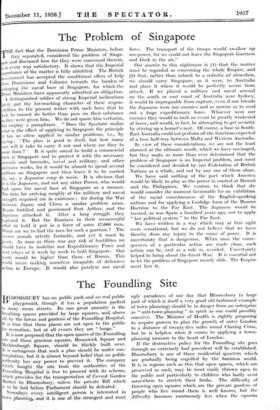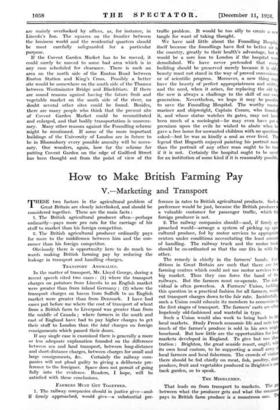The Foundling Site BLOOMSBURY has no public park and no
real public playground, though it has a population packed in many mean streets. Its one great amenity is the breathing. spaces provided by large squares, and, above all, by the lawns and gardens of the Foundling Hospital. t is true that these places are not open to the public or recreation, but at all events they are " lungs."
It is now proposed that the open spaces of the Foundling de and those gracious squares, Brunswick Square and Meeklenburgh Square, should be thickly built over. It is outrageous that such a plan should be under con- templation, but it is almost beyond belief that no public authority has any power to prevent it. The company 'which bought the site from the authorities of the oundling Hospital is free to proceed with its scheme, which provides for the transportation of Covent Garden Market to Bloomsbury, unless the private -Bill which is to be laid before Parliament should be defeated.
Nowadays &cry- intelligent person is interested in to planning. and it is one of the strangest and most ugly paradoxes of our day that Bloomsbury (a large part of which is itself a very good old-fashioned example of town planning) should be in danger from an enterprise as " anti-town-planning " in spirit as one could possibly conceive. The Minister of Health is rightly proposing to acquire powers to plan the growth of outer London to a distance of twenty-five miles round Charing Cross, but he is helpless when it comes to applying a town. planning measure to the heart of London.
If the destructive policy. for the Foundling site goes through an extremely bad precedent will be established. Bloomsbury is one of those residential quarters which are gradually being engulfed by the business world. It is in regions such as this that open spaces, which are preserved as such, may be most easily thrown open to the public and particularly to children who badly need somewhere to stretch 'their limbs. The difficulty of throwing open squares which are the private gardens of people who live round them is well known, but the difficulty . becomes enormously less when the squares are mainly overlooked by offices, as, for instance, in Lincoln's Inn. The squares on the frontier between the business world and the residential quarters should be most carefully safeguarded for a particular purpose.
If the Covent Garden Market has to be moved, it could surely be moved to some bad area which is in any case scheduled for clearance. There is such an area on the north side of the Euston Road between Euston Station and King's Cross. Possibly a better site would be somewhere on the south side of the Thames between Westminster Bridge and Blackfriars. If there are sound reasons against having the future fruit and vegetable market on the south side of the river, no doubt several other sites could be found. Besides, there are many people who think that the present site of Covent Garden Market could be reconstituted and enlarged, and that bodily transportation is unneces- sary. Many other reasons against the Foundling scheme might be mentioned. If some of the more important buildings of the University of London are in future to be in Bloomsbury every possible amenity will be neces- sary. One wonders, again, how • far the scheme for putting Covent Garden on the edge of Guilford Street has been thought out from the point of view of the traffic problem. It would be too silly to create a ne tangle for want of taking thought.
We have said little about the Foundling Hospi itself because the foundlings have fled to better air the country, greatly to their health's advantage, but i would be a sore loss to London if the hospital we demolished. We have never pretended that eve building should be preserved merely because it is old beauty must not stand in the way of proved convenien or of scientific progress. Moreover, a new thing ma have the beauty of- perfect appropriateness and utility and the need, when it arises, for replacing the old b the new is always a challenge to the skill of our o generation. Nevertheless, we hope it may be possib to save the Foundling Hospital. The worthy maste mariner and shipwright, Captain Comm, who found it, and whose statue watches its gates, may not hay been much of a sociologist—he may even have put premium upon the evils he wished to abate when h gave a free home for unwanted children with no questio asked—but he was as kindly a soul as ever lived. Th legend that Hogarth enjoyed painting his portrait mo than the portrait of any other man ought to be tru; if it is not. Certainly the hospital ought to be say for an institution of some kind if it is reasonably possible















































 Previous page
Previous page